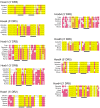Changes in Cis-regulatory Elements during Morphological Evolution
- PMID: 24832508
- PMCID: PMC4009813
- DOI: 10.3390/biology1030557
Changes in Cis-regulatory Elements during Morphological Evolution
Abstract
How have animals evolved new body designs (morphological evolution)? This requires explanations both for simple morphological changes, such as differences in pigmentation and hair patterns between different Drosophila populations and species, and also for more complex changes, such as differences in the forelimbs of mice and bats, and the necks of amphibians and reptiles. The genetic changes and pathways involved in these evolutionary steps require identification. Many, though not all, of these events occur by changes in cis-regulatory (enhancer) elements within developmental genes. Enhancers are modular, each affecting expression in only one or a few tissues. Therefore it is possible to add, remove or alter an enhancer without producing changes in multiple tissues, and thereby avoid widespread (pleiotropic) deleterious effects. Ideally, for a given step in morphological evolution it is necessary to identify (i) the change in phenotype, (ii) the changes in gene expression, (iii) the DNA region, enhancer or otherwise, affected, (iv) the mutation involved, (v) the nature of the transcription or other factors that bind to this site. In practice these data are incomplete for most of the published studies upon morphological evolution. Here, the investigations are categorized according to how far these analyses have proceeded.
Figures







References
-
- Carroll S.B., Grenier J.K., Weatherbee S.D. In: From DNA to diversity: Molecular Genetics and the Evolution of Animal Design. 2nd. Sean B.C., Jennifer K.G., editors. Blackwell Science Press; Madison, WI, USA: 2005.
Grants and funding
LinkOut - more resources
Full Text Sources
Molecular Biology Databases

